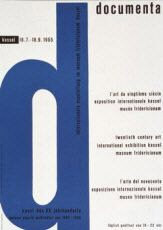Documenta 1
15 Jul - 18 Sep 1955
15 July - 18 September 1955
Kassel
The first documenta, created by Kassel painter and academy professor Arnold Bode in 1955, was an unexpected world success. The exhibition, which was launched as the accompanying program to the Bundesgartenschau (German Federal Horticultural Show) that was held in Kassel that year, took an historical and documentary/reconstructive approach. It showed the development of the major artistic groups since the beginning of the century: Fauvism, Expressionism, Cubism, Blauer Reiter, Futurism, Pittura Metafisica etc. In total, 570 works by 148 artists from six different countries were showcased, and pre-War Modernism was deliberately displayed in all its European ramifications. Bode impressively highlighted the works in the ruins of the Museums Fridericianum, today still the main building for the documenta, whose provisional premises he outfitted with what at the time were considered extremely modern materials (such as plasterboard and PVC curtains).
In terms of the exhibition concept, the documenta expressly manifested its goal of directly referencing the Nazis' propaganda exhibition "Degenerate Art" held in 1937 – in order to restore to prominence the works, styles and artists so downgraded in the German public's estimation as a result of the 1937 show. For example, Wilhelm Lehmbruck's sculpture „Kneelers“ (1911), which the Nazis had placed in a central location in the 1937 show, was again placed in the entrance area of the Fridericianum, but this time with full dignity in the stairwell rotunda. This attempt to reverse the way specific artists had been considered and thus recontextualize their work was supplemented by a centrally positioned walls of photos with portraits of the artists, thus celebrating the individual creative minds behind the works.
Werner Haftmann, art historian and the conceptual brain behind documenta 1-3, described the intention of the first documenta as follows: "It should be seen as a broad, if initial attempt, to regain international contacts across the board and thus at home re-engage in a conversation that has been interrupted for so long, as it were.“ Haftmann believed that the exhibition also had a didactic brief: “It is devised with our young generation in mind, and the artists, poets and thinkers they follow, so that they may recognize what foundations have been laid for them, what inheritance they must nurture and what inheritance must be overcome.“
Thus, alongside a retrospective glance at the past 50 years, attention was also directed toward contemporary art. The idea was, on the one hand, to take intellectual stock of things, to enquire what possibilities there were for taking up the artistic positions of the first half of the century and, on the other, to identify the role young German art could play in the international scene. In this regard, d1 was the first post-War forum where German and other European artists met again.
Artistic Director:
Arnold Bode
Artists:
Josef Albers
Kenneth Armitage
Jean Arp
René Victor Auberjonois
Giacomo Balla
Willi Baumeister
Max Beckmann
Hermann Blumenthal
Reg Butler
Eduard Bargheer
Mirko Basaldella
Max Bill
Umberto Boccioni
Ernst Barlach
Jean Bazaine
Renato Birolli
Camille Bombois
Afro Basaldella
André Beaudin
Roger Bissière
Georges Braque
Alexander Calder
Alexander Camaro
Heinrich Campendonk
Marc Chagall
Roberto Crippa
Massimo Campigli
Giuseppe Capogrossi
Carlo Dalmazzo Carrà
Giorgio de Chirico
Felice Casorati
Bruno Cassinari
Lynn Chadwick
Antonio Corpora
Robert Delaunay
Charles Despiau
Theo van Doesburg
Raoul Dufy
André Derain
Otto Dix
Raymond Duchamp-Villon
Max Ernst
Joseph Fassbender
Lyonel Feininger
Ernesto de Fiori
Xaver Fuhr
Naum Gabo
Fritz Glarner
HAP Grieshaber
Werner Gilles
Julio González
Juan Gris
Hans Hartung
Erich Heckel
Werner Heldt
Auguste Herbin
Karl Hartung
Bernhard Heiliger
Barbara Hepworth
Karl Hofer
Alexej von Jawlensky
Wassily Kandinsky
Ernst-Ludwig Kirchner
Oskar Kokoschka
Ludwig Kasper
Paul Klee
Frantisek Kupka
Berto Lardera
Henri Laurens
Fernand Léger
Kurt Lehmann
Wilhelm Lehmbruck
August Macke
Marino Marini
Otto Meyer-Amden
Giorgio Morandi
Gabriele Münter
Alberto Magnelli
André Masson
Joan Miró
Mattia Moreni
Zoran Mušič
Aristide Maillol
Ewald Mataré
Paula Modersohn-Becker
Ennio Morlotti
Alfred Manessier
Henri Matisse
Amedeo Modigliani
Richard Mortensen
Franz Marc
Georg Meistermann
Piet Mondrian
Georg Muche
Gerhard Marcks
Hans Mettel
Henry Moore
Otto Mueller
Ernst Wilhelm Nay
Rolf Nesch
Ben Nicholson
Emil Nolde
Max Pechstein
Pablo Picasso
Filippo De Pisis
Antoine Pevsner
Édouard Pignon
Hans Purrmann
Otto Ritschl
Kurt Roesch
Georges Rouault
Emy Roeder
Christian Rohlfs
Henri Rousseau
Giuseppe Santomaso
Gérard Ernest Schneider
William Scott
Mario Sironi
Edwin Scharff
Wolfgang Schulze (Wols)
Séraphine (Louis) de Senlis
Pierre Soulages
Oskar Schlemmer
Kurt Schwitters
Gino Severini
Toni Stadler
Karl Schmidt-Rottluff
Scipione (Gino Bonichi)
Gustave Singier
Graham Sutherland
Sophie Taeuber-Arp
Pierre Tal-Coat
Hann Trier
Heinz Trökes
Hans Uhlmann
Victor Vasarely
Alberto Viani
Jacques Villon
Maurice de Vlaminck
Emilio Vedova
Marie Héléne Vieira da Silva
Louis Vivin
Friedrich Vordemberge-Gildewart
Theodor Werner
Walter Kurt Wiemken
Hans Wimmer
Fritz Winter
Gustav H. Wolff

